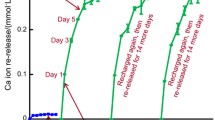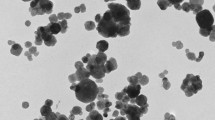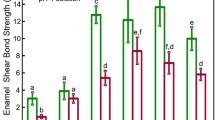Abstract
Objectives
This study aimed to develop an antibacterial and calcium (Ca) and phosphate (P) rechargeable adhesive and investigate the effects of dimethylaminododecyl methacrylate (DMAHDM) and nanoparticles of amorphous calcium phosphate (NACP) on dentin bonding, biofilm response, and repeated Ca and P ion recharge and re-release capability for the first time.
Materials and methods
Pyromellitic glycerol dimethacrylate (PMGDM), ethoxylated bisphenol A dimethacrylate (EBPADMA), 2-hydroxyethyl methacrylate (HEMA), and bisphenol A glycidyl dimethacrylate (BisGMA) formed the adhesive (PEHB). Three groups were tested: (1) Scotchbond (SBMP, 3 M) control, (2) PEHB + 30% NACP, and (3) PEHB + 30% NACP + 5% DMAHDM. Specimens were tested for dentin shear bond strength, and Ca and P ion release, recharge, and re-release. Biofilm lactic acid production and colony-forming units (CFU) on resins were analyzed.
Results
The four groups had similar dentin shear bond strengths (p > 0.1). Adhesive with DMAHDM showed significant decrease in metabolic activity, lactic acid production, and biofilm CFU (p < 0.05). The adhesives containing NACP released high levels of Ca and P ions initially and after being recharged.
Conclusion
This study developed the first Ca and P ion-rechargeable and antibacterial adhesive, achieving strong antibacterial activity and Ca and P ion recharge and re-release for long-term remineralization.
Clinical relevance
Considering the restoration-tooth bonded interface being the weak link and recurrent caries at the margins being the primary reason for restoration failures, this novel calcium phosphate-rechargeable and antibacterial adhesive is promising for a wide range of tooth-restoration applications to inhibit caries.






Similar content being viewed by others
References
Ferracane JL (2011) Resin composite–state of the art. Dent Mater 27(1):29–38
Correa MB, Peres MA, Peres KG, Horta BL, Barros AD, Demarco FF (2012) Amalgam or composite resin? Factors influencing the choice of restorative material. J Dent 40(9):703–710
Drummond JL (2008) Degradation, fatigue, and failure of resin dental composite materials. J Dent Res 87(8):710–719
Ferracane JL (2006) Hygroscopic and hydrolytic effects in dental polymer networks. Dent Mater 22(3):211–222
Watts DC, Marouf AS, Al-Hindi AM (2003) Photo-polymerization shrinkage-stress kinetics in resin-composites: methods development. Dent Mater 19(1):1–11
Lim BS, Ferracane JL, Sakaguchi RL, Condon JR (2002) Reduction of polymerization contraction stress for dental composites by two-step light-activation. Dent Mater 18(6):436–444
Wei YJ, Silikas N, Zhang ZT, Watts DC (2011) Hygroscopic dimensional changes of self-adhering and new resin-matrix composites during water sorption/desorption cycles. Dent Mater 27(3):259–266
Spencer P, Ye Q, Misra A, Goncalves SE, Laurence JS (2014) Proteins, pathogens, and failure at the composite-tooth interface. J Dent Res 93(12):1243–1249
Delaviz Y, Finer Y, Santerre JP (2014) Biodegradation of resin composites and adhesives by oral bacteria and saliva: a rationale for new material designs that consider the clinical environment and treatment challenges. Dent Mater 30(1):16–32
Opdam NJ, Bronkhorst EM, Roeters JM, Loomans BA (2007) A retrospective clinical study on longevity of posterior composite and amalgam restorations. Dent Mater 23(1):2–8
Mjor IA (2005) Clinical diagnosis of recurrent caries. J Am Dent Assoc 136(10):1426–1433
Zalkind MM, Keisar O, Ever-Hadani P, Grinberg R, Sela MN (1998) Accumulation of Streptococcus mutans on light-cured composites and amalgam: an in vitro study. J Esthet Dent 10(4):187–190
Beyth N, Domb AJ, Weiss EI (2007) An in vitro quantitative antibacterial analysis of amalgam and composite resins. J Dent 35(3):201–206
Featherstone JD (1999) Prevention and reversal of dental caries: role of low level fluoride. Community Dent Oral Epidemiol 27(1):31–40
Arnold WH, Sonkol T, Zoellner A, Gaengler P (2007) Comparative study of in vitro caries-like lesions and natural caries lesions at crown margins. J Prosthodont 16(6):445–451
Imazato S, Kinomoto Y, Tarumi H, Ebisu S, Tay FR (2003) Antibacterial activity and bonding characteristics of an adhesive resin containing antibacterial monomer MDPB. Dent Mater 19(4):313–319
Irie M, Suzuki K, Watts DC (2002) Marginal gap formation of light-activated restorative materials: effects of immediate setting shrinkage and bond strength. Dent Mater 18(3):203–210
Imazato S, Kuramoto A, Takahashi Y, Ebisu S, Peters MC (2006) In vitro antibacterial effects of the dentin primer of Clearfil Protect Bond. Dent Mater 22(6):527–532
Xu X, He L, Zhu B, Li J, Li J (2017) Advances in polymeric materials for dental applications. Polym Chem 8(5):807–823
Cheng L, Zhang K, Melo MA, Weir MD, Zhou X, Xu HH (2012) Anti-biofilm dentin primer with quaternary ammonium and silver nanoparticles. J Dent Res 91(6):598–604
Zhang K, Melo MA, Cheng L, Weir MD, Bai Y, Xu HH (2012) Effect of quaternary ammonium and silver nanoparticle-containing adhesives on dentin bond strength and dental plaque microcosm biofilms. Dent Mater 28(8):842–852
Li F, Weir MD, Xu HH (2013) Effects of quaternary ammonium chain length on antibacterial bonding agents. J Dent Res 92(10):932–938
Wang L, Melo MA, Weir MD, Xie X, Reynolds MA, Xu HH (2016) Novel bioactive nanocomposite for Class-V restorations to inhibit periodontitis-related pathogens. Dent Mater 32(12):e351–e361
Zhang N, Weir MD, Romberg E, Bai Y, Xu HH (2015) Development of novel dental adhesive with double benefits of protein-repellent and antibacterial capabilities. Dent Mater 31(7):845–854
Zhang N, Melo MA, Chen C, Liu J, Weir MD, Bai Y, Xu HH (2015) Development of a multifunctional adhesive system for prevention of root caries and secondary caries. Dent Mater 31(9):1119–1131
Zhou H, Liu H, Weir MD, Reynolds MA, Zhang K, Xu HH (2016) Three-dimensional biofilm properties on dental bonding agent with varying quaternary ammonium charge densities. J Dent 53:73–81
Xu HH, Moreau JL, Sun L, Chow LC (2011) Nanocomposite containing amorphous calcium phosphate nanoparticles for caries inhibition. Dent Mater 27(8):762–769
Melo MA, Guedes SF, Xu HH, Rodrigues LK (2013) Nanotechnology-based restorative materials for dental caries management. Trends Biotechnol 31(8):459–467
Al-Qarni FD, Tay F, Weir MD, Melo MAS, Sun J, Oates TW, Xie X, Xu HHK (2018) Protein-repelling adhesive resin containing calcium phosphate nanoparticles with repeated ion-recharge and re-releases. J Dent 78:91–99
Moreau JL, Sun L, Chow LC, Xu HH (2011) Mechanical and acid neutralizing properties and bacteria inhibition of amorphous calcium phosphate dental nanocomposite. J Biomed Mater Res B Appl Biomater 98(1):80–88
Weir MD, Chow LC, Xu HH (2012) Remineralization of demineralized enamel via calcium phosphate nanocomposite. J Dent Res 91(10):979–984
Moreau JL, Sun L, Chow LC, Xu HH (2011) Mechanical and acid neutralizing properties and bacteria inhibition of amorphous calcium phosphate dental nanocomposite. J Biomed Mater Res part B: Appl Biomater 98(1):80–88
Cheng L, Jiang Y, Hu Y, Li J, Xu HHK, He L, Ren B, Zhou X (2017) Biomaterials in caries prevention and treatment. In: Sasaki K, Suzuki O, Takahashi N (eds) Interface oral health science 2016, 1st edn. Springer Singapore, Singapore, pp 101–110
Dickens SH, Flaim GM, Takagi S (2003) Mechanical properties and biochemical activity of remineralizing resin-based Ca-PO4 cements. Dent Mater 19(6):558–566
Xu HH, Weir MD, Sun L (2007) Nanocomposites with Ca and PO4 release: effects of reinforcement, dicalcium phosphate particle size and silanization. Dent Mater 23(12):1482–1491
Xie XJ, Xing D, Wang L, Zhou H, Weir MD, Bai YX, Xu HH (2017) Novel rechargeable calcium phosphate nanoparticle-containing orthodontic cement. Int J Oral Sci 9(1):24–32
Zhang L, Weir MD, Hack G, Fouad AF, Xu HH (2015) Rechargeable dental adhesive with calcium phosphate nanoparticles for long-term ion release. J Dent 43(12):1587–1595
Xie X, Wang L, Xing D, Zhang K, Weir MD, Liu H, Bai Y, Xu HHK (2017) Novel dental adhesive with triple benefits of calcium phosphate recharge, protein-repellent and antibacterial functions. Dent Mater 33(5):553–563
Melo MA, Cheng L, Weir MD, Hsia RC, Rodrigues LK, Xu HH (2013) Novel dental adhesive containing antibacterial agents and calcium phosphate nanoparticles. J Biomed Mater Res B Appl Biomater 101(4):620–629
Zhou H, Li F, Weir MD, Xu HH (2013) Dental plaque microcosm response to bonding agents containing quaternary ammonium methacrylates with different chain lengths and charge densities. J Dent 41(11):1122–1131
Cheng L, Weir MD, Xu HH, Antonucci JM, Kraigsley AM, Lin NJ, Lin-Gibson S, Zhou X (2012) Antibacterial amorphous calcium phosphate nanocomposites with a quaternary ammonium dimethacrylate and silver nanoparticles. Dent Mater 28(5):561–572
Li F, Weir MD, Chen J, Xu HH (2014) Effect of charge density of bonding agent containing a new quaternary ammonium methacrylate on antibacterial and bonding properties. Dent Mater 30(4):433–441
Imazato S, Ehara A, Torii M, Ebisu S (1998) Antibacterial activity of dentine primer containing MDPB after curing. J Dent 26(3):267–271
Cheng L, Exterkate RA, Zhou X, Li J, ten Cate JM (2011) Effect of Galla chinensis on growth and metabolism of microcosm biofilms. Caries Res 45(2):87–92
McBain AJ, Sissons C, Ledder RG, Sreenivasan PK, De Vizio W, Gilbert P (2005) Development and characterization of a simple perfused oral microcosm. J Appl Microbiol 98(3):624–634
Lima JP, Sampaio de Melo MA, Borges FM, Teixeira AH, Steiner-Oliveira C, Nobre Dos Santos M, Rodrigues LK, Zanin IC (2009) Evaluation of the antimicrobial effect of photodynamic antimicrobial therapy in an in situ model of dentine caries. Eur J Oral Sci 117(5):568–574
Chen C, Weir MD, Cheng L, Lin NJ, Lin-Gibson S, Chow LC, Zhou X, Xu HH (2014) Antibacterial activity and ion release of bonding agent containing amorphous calcium phosphate nanoparticles. Dent Mater 30(8):891–901
Regnault WF, Icenogle TB, Antonucci JM, Skrtic D (2008) Amorphous calcium phosphate/urethane methacrylate resin composites. I. Physicochemical characterization. J Mater Sci Mater Med 19(2):507–15
Xu X, Costin S (2014) Antimicrobial polymeric dental materials. In: Muñoz-Bonilla A, Cerrada M, Fernández-García M (eds) Polymeric materials with antimicrobial ativity: from synthesis to ppplications, 1st edn. The Royal Society of Chemistry, UK, pp 279–309
Maltz M, Emilson CG (1982) Susceptibility of oral bacteria to various fluoride salts. J Dent Res 61(6):786–790
Xu X, Wang Y, Liao S, Wen ZT, Fan Y (2012) Synthesis and characterization of antibacterial dental monomers and composites. J Biomed Mater Res B Appl Biomater 100(4):1151–1162
Melo MA, Weir MD, Rodrigues LK, Xu HH (2013) Novel calcium phosphate nanocomposite with caries-inhibition in a human in situ model. Dent Mater 29(2):231–240
You C, Han C, Wang X, Zheng Y, Li Q, Hu X, Sun H (2012) The progress of silver nanoparticles in the antibacterial mechanism, clinical application and cytotoxicity. Mol Biol Rep 39(9):9193–9201
Hackenberg S, Scherzed A, Kessler M, Hummel S, Technau A, Froelich K, Ginzkey C, Koehler C, Hagen R, Kleinsasser N (2011) Silver nanoparticles: evaluation of DNA damage, toxicity and functional impairment in human mesenchymal stem cells. Toxicol Lett 201(1):27–33
Martinez-Gutierrez F, Guajardo-Pacheco JM, Noriega-Trevino ME, Thi EP, Reiner N, Orrantia E, Av-Gay Y, Ruiz F, Bach H (2013) Antimicrobial activity, cytotoxicity and inflammatory response of novel plastics embedded with silver nanoparticles. Future Microbiol 8(3):403–411
Durner J, Stojanovic M, Urcan E, Hickel R, Reichl FX (2011) Influence of silver nano-particles on monomer elution from light-cured composites. Dent Mater 27(7):631–636
Padovani GC, Feitosa VP, Sauro S, Tay FR, Duran G, Paula AJ, Duran N (2015) Advances in dental materials through nanotechnology: facts, perspectives and toxicological aspects. Trends Biotechnol 33(11):621–636
Imazato S (2009) Bio-active restorative materials with antibacterial effects: new dimension of innovation in restorative dentistry. Dent Mater J 28(1):11–19
Duarte SJ, Lolato AL, de Freitas CR, Dinelli W (2005) SEM analysis of internal adaptation of adhesive restorations after contamination with saliva. J Adhes Dent 7(1):51–56
Loguercio AD, Reis A, Bortoli G, Patzlaft R, Kenshima S, Rodrigues Filho LE, Accorinte Mde L, van Dijken JW (2006) Influence of adhesive systems on interfacial dentin gap formation in vitro. Oper Dent 31(4):431–441
Loesche WJ (1986) Role of Streptococcus mutans in human dental decay. Microbiol Rev 50(4):353–380
Yap AU, Tan SH, Wee SS, Lee CW, Lim EL, Zeng KY (2001) Chemical degradation of composite restoratives. J Oral Rehabil 28(11):1015–1021
Do D, Orrego S, Majd H, Ryou H, Mutluay MM, Xu HHK, Arola D (2013) Accelerated fatigue of dentin with exposure to lactic acid. Biomaterials 34(34):8650–8659
Antonucci JM, Zeiger DN, Tang K, Lin-Gibson S, Fowler BO, Lin NJ (2012) Synthesis and characterization of dimethacrylates containing quaternary ammonium functionalities for dental applications. Dent Mater 28(2):219–228
Cheng YJ, Zeiger DN, Howarter JA, Zhang X, Lin NJ, Antonucci JM, Lin-Gibson S (2011) In situ formation of silver nanoparticles in photocrosslinking polymers. J Biomed Mater Res B Appl Biomater 97(1):124–131
Hiraishi N, Yiu CK, King NM, Tay FR (2010) Effect of chlorhexidine incorporation into a self-etching primer on dentine bond strength of a luting cement. J Dent 38(6):496–502
Acknowledgements
We thank Dr. Lin Wang for his assistance, and Esstech and Caulk/Dentsply for donating materials.
Funding
This study was funded by the NIH, grant number R01 DE17974 (HX) and a bridge grant (HX) from the University of Maryland School of Dentistry.
Author information
Authors and Affiliations
Contributions
Conceptualization by Faisal al-Qarni and Hockin H. K. Xu; methodology by Faisal al-Qarni, Yousif Al-Dulaijan, Michael Weir, and Mary A. Melo; data curation by Faisal al-Qarni and Yousif Al-Dulaijan; writing—original draft preparation by Faisal al-Qarni, and Khalid S. Almulhim; writing—review and editing by Faisal al-Qarni, Khalid S. Almulhim, and Hockin H. K. Xu; supervision: Hockin H. K. Xu. All authors have read and agreed to the published version of the manuscript.
Corresponding author
Ethics declarations
Conflict of interest
The authors declare no competing interests.
Additional information
Publisher's note
Springer Nature remains neutral with regard to jurisdictional claims in published maps and institutional affiliations.
Rights and permissions
About this article
Cite this article
al-Qarni, F., Weir, M., Melo, M.A. et al. Novel calcium phosphate ion-rechargeable and antibacterial adhesive to inhibit dental caries. Clin Oral Invest 26, 313–323 (2022). https://doi.org/10.1007/s00784-021-04002-7
Received:
Accepted:
Published:
Issue Date:
DOI: https://doi.org/10.1007/s00784-021-04002-7




